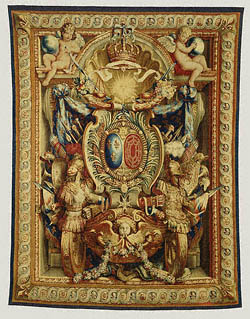• List the different objects you can identify on this tapestry. What do these objects have in common?
• With the imagery of a chariot, armor, shields, spears, and arrows, what do you think is the subject of this tapestry?
• This tapestry represents the triumphs of a specific person. By looking at the images and symbols on this tapestry what kind of person do you think this tapestry represents?
• This tapestry design was used throughout the king's palace. What message does this send about Louis XIV and his reign, as people would encounter this image over and over again?
• What would you guess this object is made of?
• While this object might look like a painting, it is actually a type of tapestry called a portière, or door hanging, and would have been used to cover a doorway. Why do you suppose it would have been hung in a doorway?
• Compare the imagery on this tapestry to the Cabinet on Stand, by André-Charles Boulle. How do you see the function of the decorative arts made under the reign of Louis XIV as serving the purposes of propaganda and power?
• What objects do you have in your home that represent you or your family? |
This tapestry is known as a portière, or door hanging, and would have been used to cover a doorway to keep out drafts. This type of tapestry was widely used in palaces throughout the 17th and 18th centuries. Their frequent appearance and prominent placement made them suitable for displaying heraldic arms in royal residences.
This design is known as the Char de Triomphe, or Chariot of Triumph, and was created by the artist Charles Le Brun. Its royal heraldic symbols—the crown, the scales of justice, an image of the sun (Apollo the sun god, Louis XIV's symbol), a ribbon with the king's faded motto, and a cartouche with the king's arms—would have clearly announced to visitors the importance of its owner, Louis XIV. The triumphal cart rolls over a serpent representing the king's enemies and alluding to his victories in war. The overflowing cornucopias near the top of the tapestry represent the fruits of war—peace, plentitude, and a strong government to protect the people of France. Numerous fleurs-de-lis ("flowers of the lily"), the symbol of the French royal family, adorn the border.
This portière was one of six delivered to the royal household in 1717, two years after the death of Louis XIV. Although woven for Louis XIV, this tapestry and others from the same series hung in the royal palaces year-round long after his reign ended.
About the Artist
Charles Le Brun (1619–1690) was the most important and influential designer during the reign of Louis XIV. His work in the Baroque style permeated design and decoration in almost every medium. He personally designed or supervised the production of most of the paintings, sculptures, and decorative objects commissioned by the French court.
About the Gobelins Manufactory
In 1662 Jean-Baptiste Colbert, Louis XIV's minister of finance, took over the Gobelins manufactory on behalf of the Crown; its official title became Manufacture Royale des Meubles de la Couronne (Royal Factory of Furniture to the Crown). The first director, Charles Le Brun, orchestrated numerous craftsmen, including tapestry weavers, painters, bronze workers, furniture makers, and gold- and silversmiths, who supplied objects exclusively for the king's palaces or as royal gifts. As a result of financial difficulties, the factory was forced to close in 1694, reopening in 1699 but only to produce tapestries.
The tapestries woven at the Gobelins were the finest of any produced in Europe in the 1600s and 1700s. Cartoons were ordered from leading painters such as Le Brun, one of the most prolific tapestry designers at the end of the 17th century. Skilled weavers were paid according to the difficulty of the work; those entrusted with heads and flesh tones received the highest wages. Depending on the complexity of the design, one weaver produced about three square yards per year.
During the reign of Louis XIV, tapestries celebrated the glory of the Sun King, but 18th-century subjects were lighter and more frivolous. Tapestries also sought to imitate the effects of painting, and hundreds of new dyes were developed to create a range of tonal effects. Unfortunately, these subtle effects have faded over time due to exposure to light.
|
